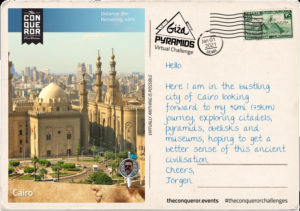Årets första 5 km runda på årets första dag! Bra start på de nya utmaningarna Conquer 2021 och Giza Pyramids.

Via e-post kom nummerlappen ”Racebib” för Giza Pyramids och Conquer 2021 loppen:


Regnet låg i luften och bjöd på en del stänk, men höll sig borta.
Startade något snabbare än jag är van vid och det kändes efter 2 km, speciellt när uppförsbackarna kom😂, men jag höll ut och joggade hela vägen, även om det gick något saktare efter det.
Med detta följde ett vykort och en lååång text som kan ses här.

Texten fortsätter här, men det är mycket att läsa!
Step into history at the crossroads of Africa, Europe and Asia where an ancient civilisation developed and thrived on the banks of the Nile River. Filled with myths and legends, pharaohs and gods, formidable pyramids, mummies and hieroglyphs, this 5,000 year old civilisation is the kingdom of the ancient Egyptians.
The Kingdom of Egypt began around 3,100BC, known as the Early Dynastic Period, with the unification of Upper and Lower Egypt. Governed by a royal family the first Pharaoh was Narmer, also referred to as Nemes. Narmer was also the first dynasty (ruling family) out of 30 that followed.
Modern historians have further divided the dynasties into various Periods/Kingdoms. The three main Kingdoms, considered as the height of civilization (the golden ages) are known as: Old Kingdom (the Age of the Pyramids); Middle Kingdom (reunification of Egypt); and New Kingdom (the peak of power). As each Kingdom collapsed a period of civil unrest, conquests, political strife and instability ensued known as the Intermediate Periods. Each Intermediary Period ended when ruling houses reclaimed their power leading Egypt into a new age of prosperity. By 525BC the great civilisation came to an end and Egypt became part of the Persian Empire. Rule passed to the Greeks in 332BC following Alexander the Great’s conquest and by 30BC after the death of Cleopatra, the last reigning pharaoh, it became a province of the Roman Empire.
The ancient cities of Memphis and Thebes were once, at different times, the capital cities of Egypt. Memphis was created by Pharaoh Narmer and served as the capital city during the Early Dynastic and Old Kingdom eras. Following reunification during the Middle Kingdom, the capital city was moved to Thebes where it continued to serve as the capital during the New Kingdom era. Only remnants remain today.
The current capital city of Egypt is Cairo and has a population of 20 million people making it the largest city in Africa and the sixth-largest in the world. Within the city is ”Historic Cairo” an area that existed before the city’s modern expansion. Declared a UNESCO site in 1979, Historic Cairo has a large collection of historic architecture including the Citadel where this journey begins.
Cairo was founded in the 10th century following the Fatimid Caliphate conquest. The Fatimid’s were a dynasty that occupied much of North Africa from the Red Sea to the Atlantic Ocean. Of Arab origin and ruling territories across the Mediterranean coast of Africa, the Fatimid’s made Egypt the centre of their caliphate.
The Fatimid’s were subsequently conquered by Saladin in the 12th century who was the first Sultan of Egypt. Saladin was a Sunni Kurd and the founder of the Ayyubid Dynasty, a Kurdish Sunni Muslim dynasty. He was a major force during the Crusaders of Jerusalem’s attempts to capture Egypt. Together with his uncle, the General at the time, Saladin seized Cairo and pushed the Crusaders out. Assuming control after his uncle’s death, Saladin began a major campaign against the Crusaders which resulted in the launching the Third Crusade by the powerful states of western Christianity. Led by Richard the Lionheart (King of England), King Phillip of France and Emperor Frederick Barbarossa (Holy Roman Emperor) the Battle of Arsuf against Saladin resulted in a truce followed by a peace treaty that lasted three years. Part of the treaty was safe passage to all Christian and Muslim unarmed pilgrims. Neither Saladin nor Richard were satisfied with the outcome. Both Richard and Saladin respected each other’s capabilities as leaders and were known to send each other gifts after the treaty. Saladin was widely regarded as a chivalrous warrior who besides being a shrewd and ruthless leader, he was also looked upon as a ”kindly father figure who cared for the poor and sick”.
Saladin was primarily responsible for commencing the construction of the Citadel of Cairo in early 12th century which was built upon, altered and adapted across the centuries to suit the rulers needs and regimes of the time. It served as the residence of rulers and seat of Government until the 19th century. The complex was initially divided into two enclosures; one used for military garrisons and the other as the sultan’s residence. By the 19th century many of the buildings within the citadel were torn down to make way for an Ottoman-style mosque with two minarets, four small domes and four semi-circular domes around a main dome. It was commissioned by Muhammad Ali, the de facto ruler of Egypt at the time, in memory of his eldest son and constructed in the style that paid homage to his former overlords, the Ottomans.
Across from Muhammad Ali’s mosque is a 14th century mosque built by the then ruler, Sultan al-Nasir Muhammad. With a rather austere appearance when compared to its neighbour, the mosque is a rectangular building constructed around an inner court with two minarets and a single dome. The minarets with their bulbous shapes are made entirely out of carved stone and extensively decorated with glazed mosaics.
During the 20th century the citadel was first occupied by the British army, followed by the Egyptian military until the government opened it to the public converting buildings into museums. Today the citadel consists of several mosques (the two main ones and two smaller ones), a military museum, carriage museum, police museum and a palace containing a 1000kg chandelier gifted by Louis-Philippe I of France.